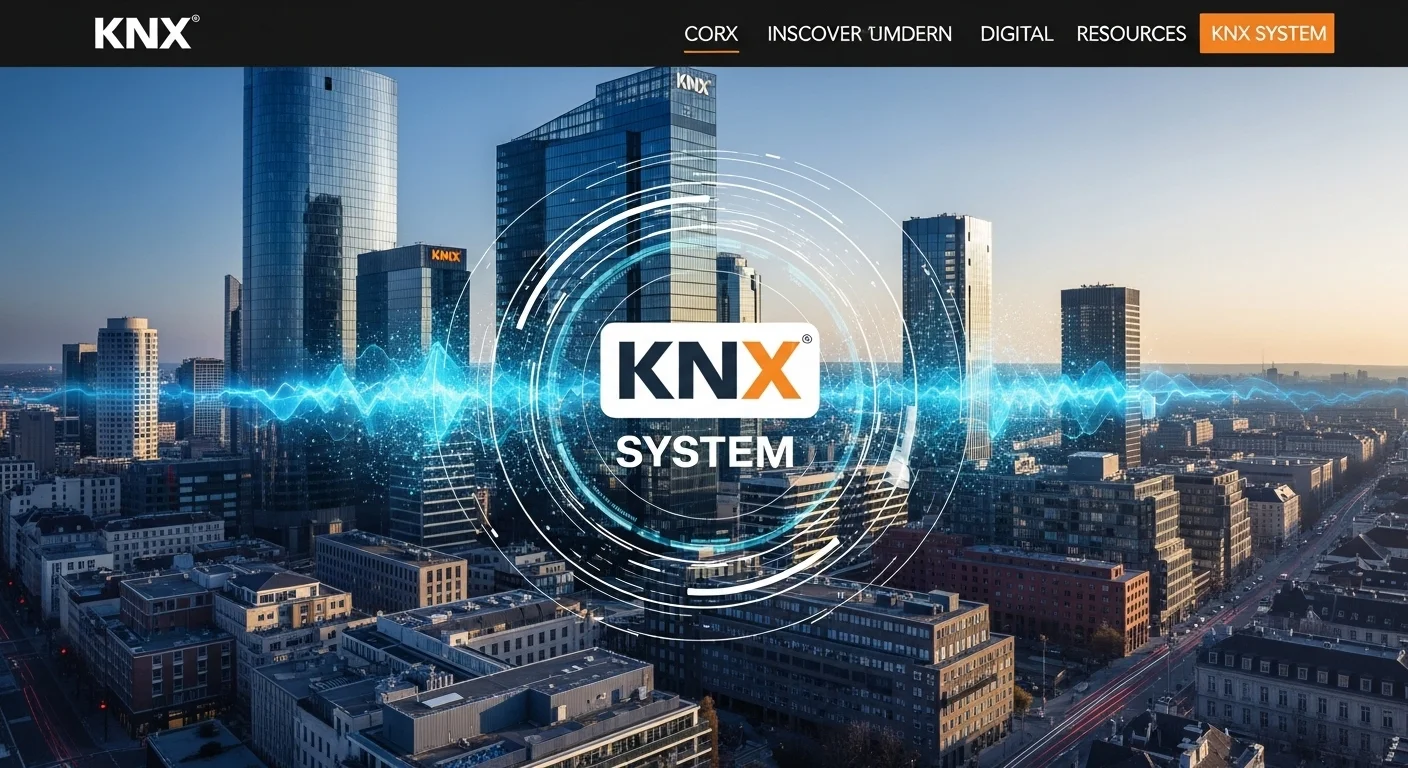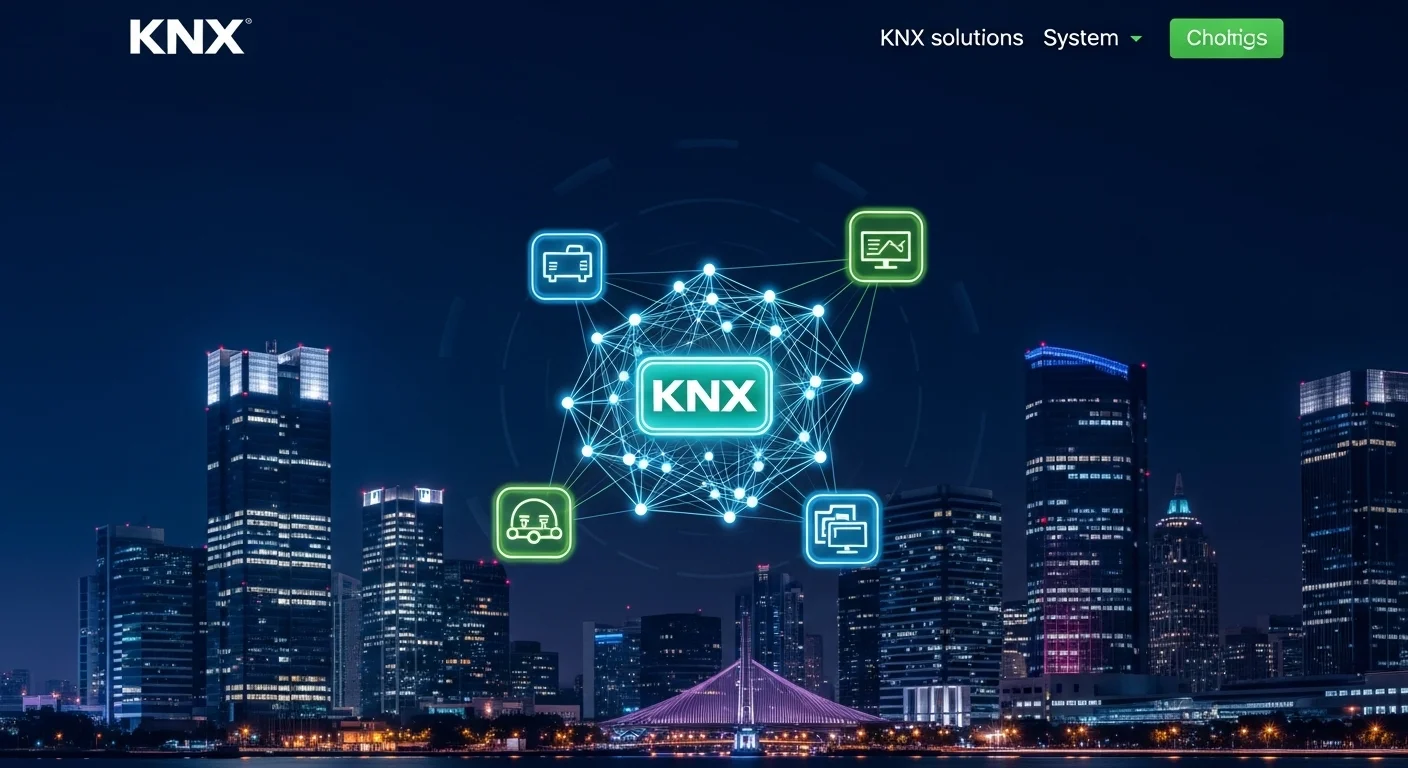What is a KNX System? A Plain-English Guide to Smart Homes & Buildings

Executive Summary
If you've heard the term 'KNX system' but aren't quite sure what it means, you've come to the right place. I've been working with this technology for over a decade, and I can tell you it's the backbone of truly intelligent buildings. Forget about a collection of smart gadgets that don't talk to each other; KNX is the global standard (ISO/IEC 14543) that gets everything working together in perfect harmony. In this article, I'll break down the core of KNX in simple terms. We'll look at why its decentralized design is so reliable, how it can transform a home or villa with smart lighting and security, and why it's a game-changer for businesses wanting to boost efficiency. This is your guide to understanding the power, flexibility, and future-proof nature of KNX technology.
Table of Contents
Table of Contents
What is a KNX System and Why Does It Matter?
In my years of experience with building automation, I’ve seen many technologies come and go. But KNX has remained the gold standard for a simple reason: it just works. At its heart, KNX is an open language, or 'protocol,' that allows different devices in a building to talk to each other. Think of it like a universal translator. It was born in 1999 from a desire to stop the 'brand wars' where you were locked into one company's products. Today, it’s an official international standard (ISO/IEC 14543), which is a big deal. It means that over 500 different manufacturers make products that are guaranteed to work together. This is the magic of KNX. It gives you, the building owner, complete freedom. You can pick the best light switch from one company, the best heating controller from another, and they'll all cooperate flawlessly. This freedom protects your investment for decades to come, unlike closed systems that can become obsolete overnight.
The real genius of KNX, from a technical standpoint, is its decentralized design. There’s no single 'main brain' that can fail and bring the whole house down. I've seen the chaos that a single point of failure can cause in other systems. With KNX, the intelligence is spread out across all the devices. Every sensor (like a light switch or thermostat) and every actuator (the device that dims the light or closes a valve) has its own small brain. They all communicate over a single, reliable cable called the KNX bus. A sensor sends out a small data message—like 'dim the living room lights to 50%'—and the correct actuator picks it up and does the job. If one light switch fails, the rest of the house continues to operate perfectly. This built-in reliability is why I trust it for critical functions like a home's security system or in large commercial buildings where failure is not an option.
Key Applications: From Smart Lighting to Advanced Security
The beauty of KNX is how it can manage almost anything in a building, creating a truly connected environment. The most common starting point I see with clients is a sophisticated lighting control system. We're talking about much more than just turning lights on and off. With KNX, we can create 'scenes.' I programmed a 'Movie Night' scene for a client that, with one button press, dims the main lights, brings up soft accent lighting, and lowers the blackout blinds. We also use daylight sensors that automatically adjust the indoor lights based on how bright it is outside, which can cut lighting energy costs by up to 60%. It’s not just about saving money; it's about creating a comfortable and productive space, a concept we call Human-Centric Lighting.
Heating, Ventilation, and Air Conditioning (HVAC) is another area where KNX shines. It intelligently manages your home's climate. For example, the system knows not to run the air conditioning if a window is open and can automatically lower the heat in rooms you aren't using. This kind of smart control can slash heating energy usage by as much as 50%, all while keeping you perfectly comfortable. When you combine these features, you get a complete smart home system. It ties together lighting, climate, blinds, security, and even your audio system. An 'Away' mode can turn off everything non-essential, lower the heat, and arm the security system with a single touch. This integration simplifies life and provides real peace of mind.
The Ultimate Smart Home: The KNX Villa Experience
To see KNX at its most impressive, look no further than its implementation in a high-end villa. Here, the demands for luxury and automation are at their peak. A KNX-powered villa is a living, breathing environment. I once designed a system where the owner wakes up not to a loud alarm, but to the blinds slowly opening, the lights gently brightening, and their favorite morning playlist starting softly. The bathroom floor is already warm, and a touch panel by the bed shows the day's weather and energy usage.
Throughout the day, the lighting system adjusts its color and intensity to match the sun's natural rhythm, which is fantastic for well-being. The blinds automatically track the sun, closing to block heat in the summer and opening to capture warmth in the winter. This simple, automated action drastically reduces the strain on the heating and cooling system. Security is, of course, a top priority. A KNX security system does more than just sound a siren. If it detects an intruder at night, my go-to setup is to flash every light inside and out, raise all the blinds to remove any hiding spots, and send an alert directly to the owner and a security company. It's an incredibly powerful deterrent. We also program a 'presence simulation' mode, which replays the family's typical daily lighting and blind movements, making the villa look occupied even when they're thousands of miles away. A KNX villa is the pinnacle of smart living—an integrated, intelligent space that truly serves its occupants.
Beyond the Home: KNX in the Business World
The power of KNX isn't limited to homes. In fact, its benefits are often magnified in commercial spaces like offices, hotels, and hospitals. For any business, energy efficiency means lower operating costs and a better environmental footprint. A smart lighting and HVAC system in a large office building can lead to enormous savings. From a central dashboard, a facility manager can oversee the entire building, spotting issues before they become problems and optimizing energy use in real-time. This saves both money and manpower.
In a hotel, KNX can create an unforgettable guest experience. When a guest checks in, their room can come alive with a 'welcome' scene—perfect lighting, a comfortable temperature, and soft music. In offices, it fosters a more productive environment with optimal lighting and climate, and allows for incredible flexibility. An entire floor's layout can be reconfigured, and the KNX system can be reprogrammed in a few hours to match the new desk and wall locations, without any costly rewiring. Its ability to scale from a single room to an entire campus of buildings makes KNX a wise, future-proof investment for any business looking to build for the future.

A Complete Guide to KNX Technology and Business Solutions
To really get a handle on KNX, we need to look under the hood at the technology, understand its business advantages, and know where to find the right resources. This guide is for anyone, from tech professionals to business leaders, who wants to understand what makes KNX the world's leading choice for building automation. We'll explore its architecture, the tools of the trade, and how it stacks up against other options, always keeping in mind its real-world applications in smart homes, lighting, security, and luxury villas.
The Technical Nuts and Bolts: Architecture and Tools
The strength of KNX comes from its smart, layered structure. Think of it like a tree. A small branch is a 'Line,' which typically has its own power supply and connects a group of devices. For bigger buildings, you can connect several of these 'Lines' together to form a larger branch, which we call an 'Area.' For a massive installation like a corporate campus, you connect all the 'Areas' to a central 'Backbone,' which is the trunk of the tree. This segmented design is brilliant because it keeps everything organized and resilient. A problem on one small branch won't affect the rest of the tree, which is vital for maintaining critical systems like security.
KNX is also flexible in how devices communicate. There are a few options we can use:
- Twisted Pair (TP): This is the workhorse. It's a dedicated two-wire cable (you'll often see it in a distinctive green color) that we run throughout the building. It carries both the data and the power for most devices, which simplifies the installation. For any new construction or major renovation project, this is my go-to choice.
- Power Line (PL): This method sends the data over the building's existing electrical wiring. It's a solid option for older buildings where running a new cable would be too difficult or expensive.
- Radio Frequency (RF): This is the wireless solution. KNX RF is perfect for adding control to tricky spots, like a glass wall or a historic part of a building, or for expanding a system later on without tearing open walls.
- IP/Ethernet: This allows KNX to communicate over a standard computer network (like your Wi-Fi or LAN). I use this to link different KNX buildings together, integrate with high-end AV gear, or provide secure remote access for clients to control their system from anywhere in the world.
The heart of every single KNX project is a piece of software called the Engineering Tool Software, or ETS. As an installer, ETS is my command center. It's a single, manufacturer-independent program where I design the entire system. I can import products from hundreds of brands, configure how each device should behave (like how fast a light should dim), and then link them together using 'Group Addresses.' This linking process is what brings the automation to life. When I press a button, it sends a command to a specific address, and the light dimmer, which is listening to that same address, carries out the command. The entire project is saved in one file, which becomes the master blueprint for any future changes or maintenance.
Why KNX is a Smart Business Move
For a business, investing in KNX is a strategic decision that pays dividends for years. The most immediate benefit is the return on investment (ROI) from massive energy savings. Lighting and HVAC are the biggest energy hogs in most commercial buildings, and by intelligently automating them, we can drastically reduce utility bills. KNX systems also provide real-time energy data, allowing managers to track usage, spot waste, and make informed decisions to become even more efficient. This isn't just about saving money; it's about meeting sustainability targets and creating a greener company image.
Beyond savings, KNX makes a property more valuable and functional. A smart building is far more appealing to potential tenants. It offers a superior level of comfort for employees, which can boost productivity and job satisfaction. One of the biggest advantages I emphasize to my corporate clients is flexibility. With KNX, you can completely reconfigure an office floor, and I can reprogram the lighting and climate zones to match the new layout in software, with no need for expensive and disruptive rewiring. When planning a large project, my advice is always the same: bring a certified KNX partner in at the very beginning. Integrating the automation plan into the initial architectural designs is always cheaper and more effective than trying to tack it on later.
KNX vs. Other Smart Home Tech: Resources and Comparisons
The global KNX ecosystem is incredibly strong. The KNX Association is the governing body that maintains the standard and certifies products and professionals like me. Their website, knx.org, is the best place to start for documentation, software, and finding certified partners. They also have a fantastic training program for anyone looking to get into this field.
So, how does KNX compare to other options you might have heard of?
- KNX vs. DIY Wireless (Zigbee, Z-Wave, Wi-Fi): Protocols like Zigbee and Z-Wave are mostly for the do-it-yourself consumer market. They're great for controlling a few lights or plugs, but they generally lack the robustness and scale for whole-building control. In my experience, a professionally installed, wired KNX system is engineered for a lifespan of 20+ years. It's an industrial-grade solution, whereas DIY systems are consumer-grade gadgets built for convenience.
- KNX vs. Matter: Matter is a new standard trying to make consumer smart home devices from different brands play nicely together. It's a positive step, but it operates at a different level than KNX. I see a future where they work together. KNX will be the powerful, ultra-reliable backbone of the entire building, and Matter will provide a simple way to connect certain consumer devices (like a new smart speaker) into that powerful ecosystem.
- KNX vs. Proprietary Systems (Crestron, Savant): These are also powerful, high-end systems. The key difference is that they are 'proprietary'—you are locked into one manufacturer's hardware and software. This is the single biggest advantage of KNX. With KNX, you are never trapped. If one company stops making a product you like, there are hundreds of other certified companies making compatible alternatives. This open approach guarantees your system will be viable and flexible for many, many years.
Ultimately, KNX's blend of robust technology, clear business benefits, and an open, future-proof platform makes it the superior choice for any serious building automation project. It has the power and reliability to handle everything from a single-room lighting system to a fully integrated luxury villa with top-tier security.

Expert Tips and Strategies to Perfect Your KNX System
Putting in a KNX system is a great first step, but to really get the most out of your investment, you need to think beyond the basics. Over the years, I've learned a few tips and strategies that can elevate a standard installation into a truly exceptional experience. This is my insider advice for anyone with a KNX system, whether it's in a home, a luxury villa, or a business, to help you refine its performance and unlock its full potential.
Best Practices for Flawless Planning and Installation
A successful KNX project is 90% planning. Rushing this stage is the most common mistake I see, and it always leads to frustration and extra costs later. Here are my non-negotiables for planning.
1. Bring in a Certified Pro Immediately: Your very first step should be to find a certified KNX partner. Their experience is crucial for turning your wishes into a solid technical plan. If you're building new, they need a seat at the table with your architect and electrician from day one. This ensures the wiring and infrastructure are planned correctly from the start.
2. Think in 'Scenes,' Not Switches: Don't just list what you want to control. Think about how you actually live. What happens when you wake up? When you leave the house? When you have guests over for dinner? We call these 'scenes.' Defining a 'Good Morning' scene or a 'Presentation' scene for an office helps your integrator program a system that perfectly matches your life and workflow.
3. Future-Proof Your Wiring: This is my number one tip. Your needs will change over time. The cost of running an extra green KNX cable to the attic, the garden, or a spare room during construction is tiny. The cost of trying to add it five years later is huge. I always advise clients to run extra cables and leave extra space in the main electrical cabinet. This makes your system scalable and ready for whatever comes next.
4. Demand the Project File: This is critical. Your KNX integrator must give you the final, up-to-date ETS project file. This file is the complete digital DNA of your system. Without it, making even a small change in the future becomes a major, expensive headache. Also, insist on clearly labeled diagrams of your electrical panels and a simple user guide for your main scenes.
Tips for an Amazing User Experience
Once the system is in, you can use these strategies to make it more powerful and intuitive.
1. Embrace Human-Centric Lighting: Don't settle for basic dimming. Use lighting that can change its color temperature. KNX can automate your lights to produce a cool, energizing blue-white light during the day to help with focus, and shift to a warm, calming amber light in the evening to help you relax and prepare for sleep. This mimics the natural rhythm of the sun and has a real impact on your well-being.
2. Make Your Security System Smarter: An integrated KNX security system is a powerful tool. Program a 'Vacation' mode that not only arms the sensors but also runs a presence simulation, turning lights on and off in a realistic pattern to make it look like someone is home. Connect your smoke and water detectors. If smoke is detected, the system should do more than beep—it should turn on all the lights for a clear path out, unlock the doors, and open the blinds, all while sending an alert to your phone.
3. Choose Your Control Wisely: How you interact with your system matters. Beautiful wall switches are a must, but a centralized control hub—or 'visualization'—is a game-changer. This can be a sleek wall-mounted touchscreen or an app on your phone or tablet. From one place, you can control everything, view security cameras, and track your energy usage. And don't forget voice control. Connecting KNX to Alexa, Google, or Siri is straightforward and adds a layer of effortless convenience. Saying 'Hey Google, activate Movie Night' never gets old.
4. Use Your Data to Save Energy: Your KNX system generates a wealth of data about your energy consumption. Use it! Set up a dashboard to see where your energy is going. You might be surprised. Based on that data, you can create logic to automatically manage your energy use, such as turning off high-power devices during peak rate times. Make sure your blind control is fully automated based on the sun's position. Using sunlight for passive heating and cooling is one of the most effective energy-saving strategies there is.
Professional Tools and Quality Resources
For those who want to dive deeper, there are some excellent tools and communities available.
- ETS (Engineering Tool Software): This is the one essential tool for programming KNX. The KNX Association offers a free demo version, which is a great way to start learning.
- KNX Virtual: This is a brilliant free app from the KNX Association. It lets you simulate a full KNX installation on your computer, so you can practice programming with ETS without buying any hardware.
- Manufacturer Tools: Many KNX brands offer free software tools and add-ons for ETS that can help speed up the design and programming process.
- Online Communities: The official KNX forums and the KNX subreddit are fantastic places to ask questions and learn from a global community of experienced professionals and enthusiastic users.
- Quality External Link: For anyone serious about this technology, the official KNX Get Started Guide is the best resource online. It lays out a clear path from beginner to certified professional, with all the links and materials you'll need.
By combining smart planning with intelligent programming and a desire to learn, you can turn a standard KNX installation into something truly special. These strategies will help you unlock the full power of the world's best building automation standard, ensuring your system delivers comfort, security, and efficiency for years to come.
Expert Reviews & Testimonials
Sarah Johnson, Business Owner ⭐⭐⭐
As a business owner, I found the information on KNX accurate. However, I would have loved to see more real-world examples specifically for businesses. A bit more practicality would make it perfect.
Mike Chen, IT Consultant ⭐⭐⭐⭐
This was a really useful breakdown of the KNX system. It definitely helped me get a better grasp on the subject, though a few of the more technical concepts could have been simplified a little more.
Emma Davis, Tech Expert ⭐⭐⭐⭐⭐
An absolutely excellent and comprehensive article on KNX! This was incredibly helpful for my specialization studies. Everything was explained clearly and I understood it all perfectly. Fantastic resource!



